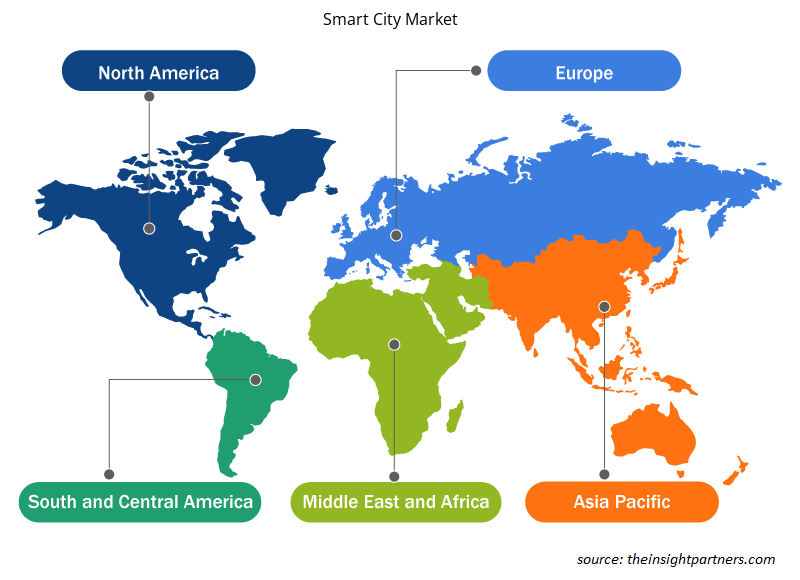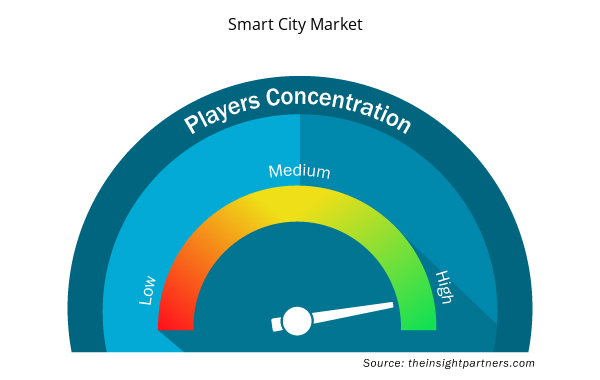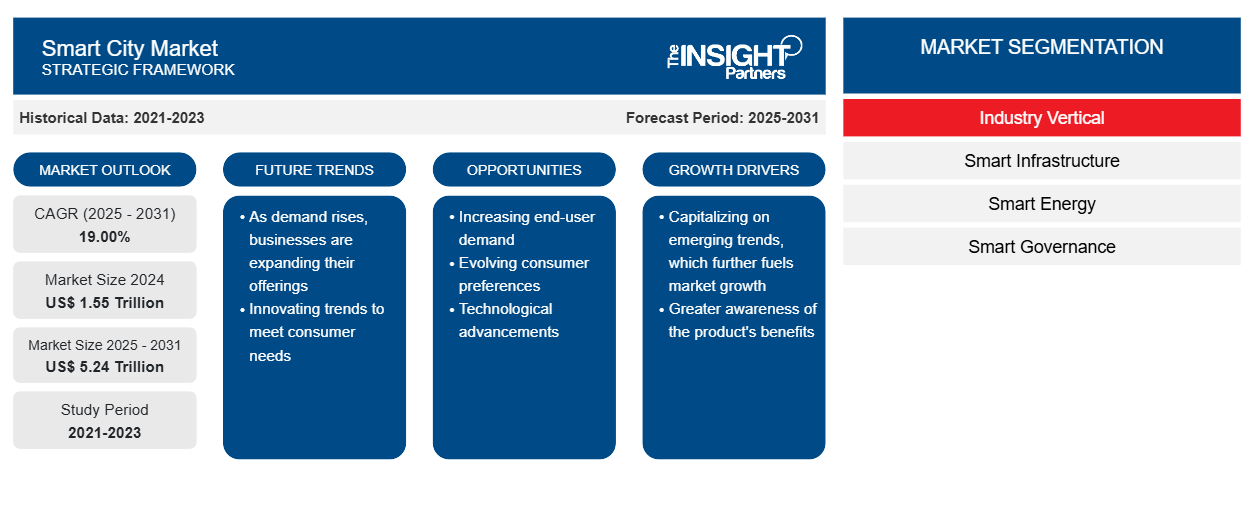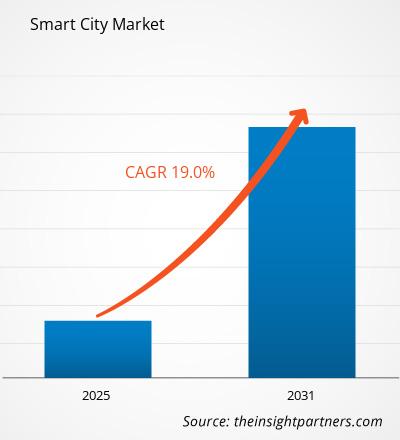من المتوقع أن ينمو سوق المدينة الذكية من 1094.23 مليار دولار أمريكي في عام 2022 إلى 3110.58 مليار دولار أمريكي بحلول عام 2031؛ ومن المتوقع أن ينمو بمعدل نمو سنوي مركب قدره 19.0٪ من عام 2022 إلى عام 2031.
المدن الذكية هي مفهوم يعتمد على تقنيات متقدمة في جوانب مختلفة من المدينة أو المقاطعة. تستخدم هذه المدن التكنولوجيا الرقمية والإنترنت لتحسين أداء الخدمات وجودة الحياة من خلال تحسين الطاقة وتحسين الأمن للمواطنين. يهدف مفهوم المدينة الذكية إلى تطوير اتصال وبنية أساسية قوية لتمكين الوصول إلى المعلومات في الوقت الفعلي لبناء نظام إدارة يربط المواطنين ومقدمي الخدمات والإداريين بكفاءة. علاوة على ذلك، تضمن الحكومة مشاركة السكان بنشاط في تحسين الاستدامة الشاملة وإنتاجية الخدمات من خلال تزويد المدن بالبنية الأساسية الأساسية.
لقد تغيرت تكنولوجيا البنية التحتية الذكية بشكل كبير بمرور الوقت، ويتم الآن اعتماد العديد من التخصصات، مثل أتمتة المباني لإدارة المرافق والاستجابة للطوارئ، وتحسين طاقة المباني، وإدارة مواقف السيارات، وأنظمة الاتصالات داخل المباني، على نطاق واسع. علاوة على ذلك، احتلت مبادرات البناء الأخضر مركز الصدارة في العديد من البلدان، وخاصة في أوروبا وأمريكا الشمالية ومنطقة آسيا والمحيط الهادئ. إن التركيز على الحد من استهلاك الطاقة والمخاوف بشأن انتشار النفايات البيئية هي العوامل الرئيسية الدافعة لتطوير المدن الذكية. ومن المتوقع أن يكون النقل مجال تركيز رئيسي آخر خلال فترة توقعات سوق المدينة الذكية .
قم بتخصيص هذا التقرير ليناسب متطلباتك
ستحصل على تخصيص لأي تقرير - مجانًا - بما في ذلك أجزاء من هذا التقرير، أو تحليل على مستوى الدولة، وحزمة بيانات Excel، بالإضافة إلى الاستفادة من العروض والخصومات الرائعة للشركات الناشئة والجامعات
- احصل على أهم اتجاهات السوق الرئيسية لهذا التقرير.ستتضمن هذه العينة المجانية تحليلاً للبيانات، بدءًا من اتجاهات السوق وحتى التقديرات والتوقعات.
إن استنفاد مصادر الطاقة والإدارة غير الفعّالة للموارد أصبحا يشكلان مصدر قلق كبير في مختلف أنحاء العالم. وهذا من شأنه أن يدفع الطلب على حلول الطاقة الذكية في مختلف أنحاء العالم. وتستخدم أنظمة إدارة الطاقة الذكية أجهزة استشعار، وعدادات متقدمة، ومصادر طاقة متجددة ، وضوابط رقمية، وأدوات تحليلية لأتمتة ومراقبة وتحسين توزيع الطاقة واستخدامها. وتعمل مثل هذه الأنظمة على تحسين تشغيل الشبكة واستخدامها من خلال موازنة احتياجات مختلف أصحاب المصلحة المعنيين (المستهلكين والمنتجين والموردين). وهناك العديد من الابتكارات في البنية الأساسية للطاقة الذكية، مثل توليد الطاقة المتجددة الموزعة، والشبكات الصغيرة، وتقنيات الشبكة الذكية، وتخزين الطاقة، والاستجابة الآلية للطلب، ومحطات الطاقة الافتراضية، والابتكارات المتعلقة بالطلب مثل المركبات الكهربائية والأجهزة الذكية. وتوفر مثل هذه الابتكارات شبكة ممتدة من أجهزة الطاقة الذكية في مختلف أنحاء المدينة، مع عرض تفصيلي لأنماط استهلاك الطاقة، وتمكين برامج مراقبة الطاقة القائمة على المجتمع وتحسين كفاءة استخدام الطاقة في المباني.
التحليل الإقليمي لسوق المدينة الذكية
من منظور إقليمي، استحوذت أمريكا الشمالية على أكبر حصة من سوق المدن الذكية العالمية في عام 2021. يساهم التبني العالي للحلول المتقدمة تقنيًا في جميع القطاعات الصناعية في المنطقة في نمو سوق المدن الذكية في أمريكا الشمالية. إن الدعم الحكومي المتزايد لتبني التكنولوجيا من خلال الإعلان عن الإعانات والإعفاءات الضريبية والتمويل للصناعات من أجل التطوير التكنولوجي يحفز السوق بشكل أكبر، وبالتالي يوفر فرص عمل مربحة للاعبين في سوق المدن الذكية الذين يعملون في جميع أنحاء المنطقة. على سبيل المثال، في نوفمبر 2021، أعلنت الحكومة الفيدرالية الأمريكية عن تمويل بقيمة 500 مليون دولار أمريكي بموجب قانون الاستثمار في البنية التحتية والوظائف للتغلب على تحديات المدن الذكية. بالإضافة إلى ذلك، فإن وجود العديد من اللاعبين في سوق المدن الذكية في جميع أنحاء المنطقة، والمشاركين في الابتكار المستمر وتطوير المنتجات، يدفع سوق المدن الذكية في أمريكا الشمالية بشكل أكبر.
رؤى السوق – سوق المدينة الذكية
رؤى صناعية عمودية
بناءً على الصناعة العمودية، يتم تقسيم حجم سوق المدينة الذكية إلى البنية التحتية الذكية والطاقة الذكية والحوكمة الذكية والنقل الذكي والرعاية الصحية الذكية والتعليم الذكي. ومن المتوقع أن ينمو قطاع النقل الذكي بأعلى معدل نمو سنوي مركب خلال فترة التنبؤ. النقل الذكي هو بنية تحتية مبتكرة لحركة المرور والتنقل مبنية على تقنيات جديدة ومصممة لتوفير الموارد لتحقيق أقصى قدر من الكفاءة. ومن المتوقع أن يصبح نشر التقنيات الرئيسية مثل الحوسبة السحابية و4G والتعلم من آلة إلى آلة والعمليات في المشاريع الجديدة أكثر شيوعًا في أنظمة النقل الذكية مثل السكك الحديدية، مما يوفر خدمات ركاب وبضائع فعالة في جميع أنحاء العالم، مما يؤدي إلى توليد مجموعة من الفرص للعديد من اللاعبين في الصناعة في النظام البيئي للمدن الذكية. وهذا من شأنه أيضًا أن يجذب العديد من الرأسماليين والمستثمرين، مما يؤدي إلى نمو هائل في سوق النقل الذكي.
رؤى إقليمية حول سوق المدينة الذكية
لقد قام المحللون في Insight Partners بشرح الاتجاهات والعوامل الإقليمية المؤثرة على سوق المدينة الذكية طوال فترة التوقعات بشكل شامل. يناقش هذا القسم أيضًا قطاعات سوق المدينة الذكية والجغرافيا في جميع أنحاء أمريكا الشمالية وأوروبا ومنطقة آسيا والمحيط الهادئ والشرق الأوسط وأفريقيا وأمريكا الجنوبية والوسطى.

- احصل على البيانات الإقليمية المحددة لسوق المدينة الذكية
نطاق تقرير سوق المدينة الذكية
| سمة التقرير | تفاصيل |
|---|---|
| حجم السوق في عام 2023 | 1.30 تريليون دولار أمريكي |
| حجم السوق بحلول عام 2031 | 5.24 تريليون دولار أمريكي |
| معدل النمو السنوي المركب العالمي (2023 - 2031) | 19.00% |
| البيانات التاريخية | 2021-2022 |
| فترة التنبؤ | 2024-2031 |
| القطاعات المغطاة | حسب القطاع الصناعي
|
| المناطق والدول المغطاة | أمريكا الشمالية
|
| قادة السوق وملفات تعريف الشركات الرئيسية |
|
كثافة اللاعبين في السوق: فهم تأثيرها على ديناميكيات الأعمال
يشهد سوق المدن الذكية نموًا سريعًا، مدفوعًا بالطلب المتزايد من جانب المستخدم النهائي بسبب عوامل مثل تفضيلات المستهلكين المتطورة والتقدم التكنولوجي والوعي المتزايد بفوائد المنتج. ومع ارتفاع الطلب، تعمل الشركات على توسيع عروضها والابتكار لتلبية احتياجات المستهلكين والاستفادة من الاتجاهات الناشئة، مما يؤدي إلى زيادة نمو السوق.
تشير كثافة اللاعبين في السوق إلى توزيع الشركات أو المؤسسات العاملة في سوق أو صناعة معينة. وهي تشير إلى عدد المنافسين (اللاعبين في السوق) الموجودين في مساحة سوق معينة نسبة إلى حجمها أو قيمتها السوقية الإجمالية.
الشركات الرئيسية العاملة في سوق المدينة الذكية هي:
- شركة أي بي بي المحدودة
- أكسنتشر
- سيسكو
- اريكسون
- شنايدر الكتريك
- جنرال إلكتريك
إخلاء المسؤولية : الشركات المذكورة أعلاه ليست مرتبة بأي ترتيب معين.

- احصل على نظرة عامة على أهم اللاعبين الرئيسيين في سوق المدينة الذكية
يركز اللاعبون العاملون في سوق المدينة الذكية بشكل أساسي على تطوير منتجات متقدمة وفعالة.
- في أكتوبر 2021، أعلنت شركة Siemens AG عن استحواذها على Squills. وقد عزز هذا الاستحواذ حلول التنقل التي تقدمها الشركة، مثل برامج الحجز وإصدار التذاكر.
- في مايو 2021، دخلت شركة Microsoft Corporation وشركة Itron Inc في شراكة استراتيجية للتعاون في تقديم خدمات إدارة الأجهزة المحمولة (MDM) المتقدمة للغاية لعملائهما.
تم تقسيم حجم سوق المدن الذكية إلى خمس مناطق رئيسية - أمريكا الشمالية وأوروبا ومنطقة آسيا والمحيط الهادئ والشرق الأوسط وأفريقيا وأمريكا الجنوبية. في عام 2022، قادت أمريكا الشمالية السوق بحصة كبيرة من الإيرادات، تليها أوروبا. علاوة على ذلك، من المتوقع أن تسجل منطقة آسيا والمحيط الهادئ أعلى معدل نمو سنوي مركب في سوق المدن الذكية من عام 2022 إلى عام 2031.
تشمل الجهات الفاعلة الرئيسية في سوق المدن الذكية العالمية شركة ABB Ltd؛ وCisco Systems, Inc.؛ وOracle Corporation؛ وMicrosoft Corporation؛ وIBM Corporation. وبصرف النظر عن هذه الشركات، تم تحليل العديد من الشركات الأخرى خلال دراسة البحث، بما في ذلك Accenture وGeneral Electric Company وSchneider Electric SE وSiemens AG وEricsson AB.
- التحليل التاريخي (سنتان)، السنة الأساسية، التوقعات (7 سنوات) مع معدل النمو السنوي المركب
- تحليل PEST و SWOT
- حجم السوق والقيمة / الحجم - عالميًا وإقليميًا وقطريًا
- الصناعة والمنافسة
- مجموعة بيانات Excel


- Health Economics and Outcome Research (HEOR) Services Market
- Medical Audiometer Devices Market
- Hair Extensions Market
- Cling Films Market
- Parking Management Market
- Carbon Fiber Market
- Oxy-fuel Combustion Technology Market
- Workwear Market
- Intraoperative Neuromonitoring Market
- Terahertz Technology Market

Report Coverage
Revenue forecast, Company Analysis, Industry landscape, Growth factors, and Trends

Segment Covered
This text is related
to segments covered.

Regional Scope
North America, Europe, Asia Pacific, Middle East & Africa, South & Central America

Country Scope
This text is related
to country scope.
Trends and growth analysis reports related to Electronics and Semiconductor : READ MORE..
The List of Companies - Smart Cities Market
- ABB Ltd.
- Accenture
- Cisco
- Ericsson
- Schneider Electric
- GE
- Microsoft
- IBM Corporation
- Oracle
- Siemens
The Insight Partners performs research in 4 major stages: Data Collection & Secondary Research, Primary Research, Data Analysis and Data Triangulation & Final Review.
- Data Collection and Secondary Research:
As a market research and consulting firm operating from a decade, we have published and advised several client across the globe. First step for any study will start with an assessment of currently available data and insights from existing reports. Further, historical and current market information is collected from Investor Presentations, Annual Reports, SEC Filings, etc., and other information related to company’s performance and market positioning are gathered from Paid Databases (Factiva, Hoovers, and Reuters) and various other publications available in public domain.
Several associations trade associates, technical forums, institutes, societies and organization are accessed to gain technical as well as market related insights through their publications such as research papers, blogs and press releases related to the studies are referred to get cues about the market. Further, white papers, journals, magazines, and other news articles published in last 3 years are scrutinized and analyzed to understand the current market trends.
- Primary Research:
The primarily interview analysis comprise of data obtained from industry participants interview and answers to survey questions gathered by in-house primary team.
For primary research, interviews are conducted with industry experts/CEOs/Marketing Managers/VPs/Subject Matter Experts from both demand and supply side to get a 360-degree view of the market. The primary team conducts several interviews based on the complexity of the markets to understand the various market trends and dynamics which makes research more credible and precise.
A typical research interview fulfils the following functions:
- Provides first-hand information on the market size, market trends, growth trends, competitive landscape, and outlook
- Validates and strengthens in-house secondary research findings
- Develops the analysis team’s expertise and market understanding
Primary research involves email interactions and telephone interviews for each market, category, segment, and sub-segment across geographies. The participants who typically take part in such a process include, but are not limited to:
- Industry participants: VPs, business development managers, market intelligence managers and national sales managers
- Outside experts: Valuation experts, research analysts and key opinion leaders specializing in the electronics and semiconductor industry.
Below is the breakup of our primary respondents by company, designation, and region:

Once we receive the confirmation from primary research sources or primary respondents, we finalize the base year market estimation and forecast the data as per the macroeconomic and microeconomic factors assessed during data collection.
- Data Analysis:
Once data is validated through both secondary as well as primary respondents, we finalize the market estimations by hypothesis formulation and factor analysis at regional and country level.
- Macro-Economic Factor Analysis:
We analyse macroeconomic indicators such the gross domestic product (GDP), increase in the demand for goods and services across industries, technological advancement, regional economic growth, governmental policies, the influence of COVID-19, PEST analysis, and other aspects. This analysis aids in setting benchmarks for various nations/regions and approximating market splits. Additionally, the general trend of the aforementioned components aid in determining the market's development possibilities.
- Country Level Data:
Various factors that are especially aligned to the country are taken into account to determine the market size for a certain area and country, including the presence of vendors, such as headquarters and offices, the country's GDP, demand patterns, and industry growth. To comprehend the market dynamics for the nation, a number of growth variables, inhibitors, application areas, and current market trends are researched. The aforementioned elements aid in determining the country's overall market's growth potential.
- Company Profile:
The “Table of Contents” is formulated by listing and analyzing more than 25 - 30 companies operating in the market ecosystem across geographies. However, we profile only 10 companies as a standard practice in our syndicate reports. These 10 companies comprise leading, emerging, and regional players. Nonetheless, our analysis is not restricted to the 10 listed companies, we also analyze other companies present in the market to develop a holistic view and understand the prevailing trends. The “Company Profiles” section in the report covers key facts, business description, products & services, financial information, SWOT analysis, and key developments. The financial information presented is extracted from the annual reports and official documents of the publicly listed companies. Upon collecting the information for the sections of respective companies, we verify them via various primary sources and then compile the data in respective company profiles. The company level information helps us in deriving the base number as well as in forecasting the market size.
- Developing Base Number:
Aggregation of sales statistics (2020-2022) and macro-economic factor, and other secondary and primary research insights are utilized to arrive at base number and related market shares for 2022. The data gaps are identified in this step and relevant market data is analyzed, collected from paid primary interviews or databases. On finalizing the base year market size, forecasts are developed on the basis of macro-economic, industry and market growth factors and company level analysis.
- Data Triangulation and Final Review:
The market findings and base year market size calculations are validated from supply as well as demand side. Demand side validations are based on macro-economic factor analysis and benchmarks for respective regions and countries. In case of supply side validations, revenues of major companies are estimated (in case not available) based on industry benchmark, approximate number of employees, product portfolio, and primary interviews revenues are gathered. Further revenue from target product/service segment is assessed to avoid overshooting of market statistics. In case of heavy deviations between supply and demand side values, all thes steps are repeated to achieve synchronization.
We follow an iterative model, wherein we share our research findings with Subject Matter Experts (SME’s) and Key Opinion Leaders (KOLs) until consensus view of the market is not formulated – this model negates any drastic deviation in the opinions of experts. Only validated and universally acceptable research findings are quoted in our reports.
We have important check points that we use to validate our research findings – which we call – data triangulation, where we validate the information, we generate from secondary sources with primary interviews and then we re-validate with our internal data bases and Subject matter experts. This comprehensive model enables us to deliver high quality, reliable data in shortest possible time.


 احصل على عينة مجانية لهذا التقرير
احصل على عينة مجانية لهذا التقرير